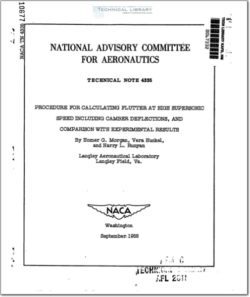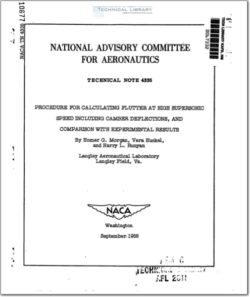NACA-TN-4335

- Version
- 55 Downloads
- 968.38 KB File Size
- 1 File Count
- December 4, 2015 Create Date
- December 4, 2015 Last Updated
National Advisory Committee for Aeronautics, Technical Notes - Procedure for Calculating Flutter at High Supersonic Speeds

A method which may be used at high supersonic Mach numbers is
described for calculating the flutter speed of wings having camber in
their deflection modes. The normal coupled vibration modes of the wing
are used to derive the equations of motion. Chord deflections of the
vibration modes are approximated by polynomials. The wing may have a
control surface and may carry external stores although no aerodynamic
forces on the stores are presented. The aerodynamic forces that are
assumed to be acting on the wing are obtained from piston theory and
also from a quasi-steady form of a theory for two-dimensional steady
flow. Airfoil shape and thickness effects are taken account of in the
analysis.
The method is used to calculate the flutter speed of some wings
which had been previously tested at Mach numbers of 1.3 to 5.0. Com-
parison of the calculations and. experiment is made for flat—plate 60°
and 15° delta wings and also for an untapered 14-50 sweptback wing.
The requirements for low drag at high speed have led to the use of
thin low-aspect-ratio wings. Structural weights must also be minimized
to avoid penalizing performance. When such wings are designed primarily
for the strength required to carry a given static load, the relative
stiffness is considerably reduced, particularly in the resistance to cam-
ber deformation. This tendency for wings to deform in camber has intro-
duced a new element in the flutter picture, namely, a need for a method
of analysis that can take into account such deformations. Such a. pro-
cedure should be suitable for programing on digital computing equipment
and could be used as a reference calculation for the correlation of data.
In reference 1, several aerodynamic theories were discussed and used
in comparative flutter calculations. Piston theory, described in detail
in references 2 and 5, was one of the stapler methods discussed. It was
shown to give results in agreement with more exact theories when used in
,two-degree-of-freedom flutter calculations for Mach numbers greater than
about 2. It is easily adaptable to the present problem of including cam-
ber deformations, because of its inherent simplicity. A quasi-steady
aerodynamic method, deduced from second-order steady-flow theory, was
also tried for comparison with piston theory. Both of these methods
allow the effects of airfoil shape and thickness, which are not treated
in the linearized aerodynamic theories, to be included.
| File | Action |
|---|---|
| naca-tn-4335.pdf | Download |
Comment On This Post